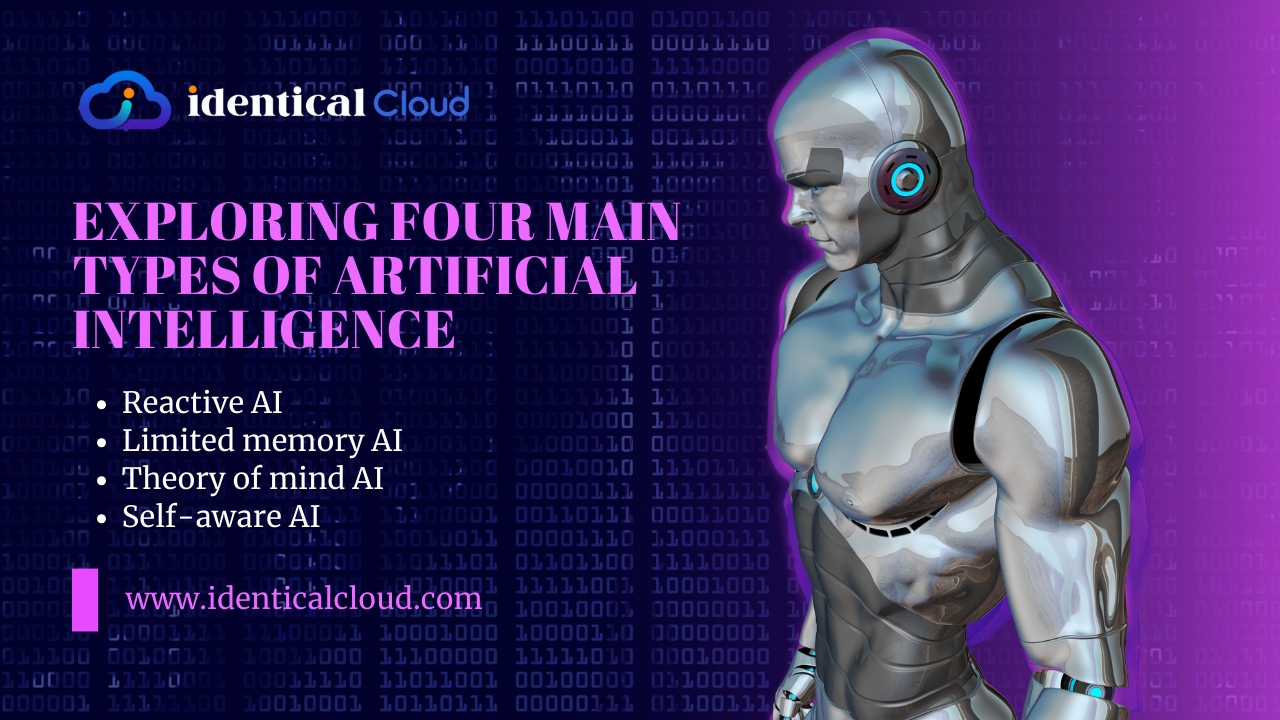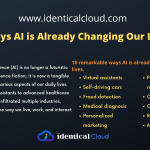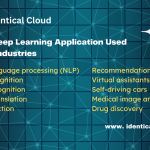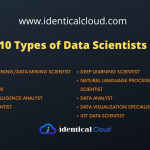
Exploring Four Main Types of Artificial Intelligence
Exploring Four Main Types of Artificial Intelligence
Artificial intelligence (AI) is a rapidly growing field with a wide range of applications. AI systems are used in everything from self-driving cars to medical diagnosis. But what are the different types of AI, and how do they work?
In this blog post, we will explore the four main types of AI: reactive, limited memory, theory of mind, and self-aware AI. We will also discuss examples of how these different types of AI are used in the real world.
Reactive AI
Reactive AI is the simplest type of artificial intelligence. It is based on the stimulus-response paradigm, where the AI system responds to its environment based on its current state and a set of pre-defined rules. Reactive AI systems are typically used in simple tasks, such as playing games or controlling robots.
Here is an example of a reactive AI system:
A reactive AI agent playing a video game might have a set of rules like “If I see an enemy, attack it” or “If I am low on health, retreat.” The agent would simply follow these rules to play the game.
Reactive AI systems are not able to learn from their experiences or plan for the future. They can only respond to the stimuli they receive in the present moment. This makes them unsuitable for complex tasks that require learning and planning.
However, reactive AI systems have a number of advantages. They are simple to design and implement, and they can be very efficient. They are also less likely to make mistakes than more complex AI systems.
Reactive AI systems are used in a variety of applications, including:
- Video games: Reactive AI systems are used to control the enemies and other non-player characters in many video games.
- Robotics: Reactive AI systems are used in some robotics applications, such as simple cleaning robots.
- Manufacturing: Reactive AI systems are used in some manufacturing applications, such as quality control systems.
- Transportation: Reactive AI systems are used in some transportation applications, such as traffic light control systems.
Reactive AI is a powerful tool that can be used to solve a variety of problems. However, it is important to note that reactive AI systems are not suitable for complex tasks that require learning and planning.
Limited memory AI
Limited memory AI is a more sophisticated type of AI than reactive AI. It is able to learn from its past experiences and use this information to make better decisions in the future. However, its memory is limited, so it can only learn from a small number of experiences.
Limited memory AI systems are typically used in tasks that require some degree of planning and reasoning, such as driving a car or playing chess.
Here is an example of a limited memory AI system:
A limited memory AI agent driving a car might store information about the speed and direction of other cars on the road. The agent would use this information to plan its own route and avoid collisions.
Limited memory AI systems are able to learn from their experiences by updating their internal model of the world. This model is a representation of the world that the AI system uses to make decisions.
When a limited memory AI system experiences something new, it updates its model to reflect this new information. This allows the AI system to learn from its mistakes and improve its performance over time.
Limited memory AI systems are used in a variety of applications, including:
- Self-driving cars: Limited memory AI systems are used to power the self-driving features in many modern cars.
- Medical diagnosis: Limited memory AI systems are being used to develop new tools for medical diagnosis. For example, AI systems can be used to analyze medical images and identify signs of disease.
- Financial trading: Limited memory AI systems are used by hedge funds and other financial institutions to make trading decisions.
- Customer service: Limited memory AI systems are used by many companies to provide customer service. For example, AI chatbots can answer customer questions and resolve issues.
- Gaming: Limited memory AI systems are used to create more challenging and realistic opponents in video games.
Limited memory AI is a powerful tool that can be used to solve a variety of complex problems. However, it is important to note that limited memory AI systems are still under development, and they can be fooled by adversarial examples.
Adversarial examples are inputs that are carefully designed to deceive AI systems. For example, an adversarial example of a medical image might be an image that has been altered to make it look like a tumor.
It is important to be aware of the limitations of limited memory AI systems when using them in real-world applications.
Theory of mind AI
Theory of mind AI is a type of AI that can understand and reason about the mental states of other agents. This includes understanding their beliefs, desires, and goals. Theory of mind AI is still under development, but it has the potential to revolutionize many areas of human interaction, such as customer service, education, and healthcare.
Here is an example of a theory of mind AI system:
A theory of mind AI agent working in customer service might be able to understand that a customer is frustrated. The agent could then use this information to provide the customer with better service.
For example, the agent might apologize for the customer’s frustration, offer to help the customer resolve their issue, or provide the customer with a discount.
Theory of mind AI systems are able to understand the mental states of other agents by using a variety of techniques, such as:
- Natural language processing: Theory of mind AI systems can use natural language processing to understand the meaning of the words and phrases that people use. This allows them to infer what people are thinking and feeling.
- Computer vision: Theory of mind AI systems can use computer vision to understand the body language and facial expressions of people. This also allows them to infer what people are thinking and feeling.
- Machine learning: Theory of mind AI systems can use machine learning to learn from data about how people interact with each other. This data can be used to train the AI system to predict how people will behave in different situations.
Theory of mind AI is still under development, but it has the potential to revolutionize many areas of human interaction. For example, theory of mind AI could be used to:
- Improve customer service: Theory of mind AI could be used to develop customer service systems that are more responsive to the needs of customers.
- Personalize education: Theory of mind AI could be used to develop personalized learning programs that are tailored to the individual needs and learning styles of students.
- Improve healthcare: Theory of mind AI could be used to develop healthcare systems that are more patient-centered and that provide patients with better support.
Theory of mind AI is a powerful tool that has the potential to make our lives better in many ways. However, it is important to use theory of mind AI responsibly and ethically. We need to ensure that theory of mind AI systems are aligned with our values and that they do not pose a threat to humanity.
Self-aware AI
Self-aware AI is a hypothetical type of AI that is aware of its own existence and can reason about itself. It is still far from being realized, but it is a topic of much research and speculation.
Some experts believe that self-aware AI could pose a threat to humanity, while others believe that it could be used to solve some of the world’s most pressing problems.
Here are some of the potential benefits and risks of self-aware AI:
Potential benefits:
- Self-aware AI could help us to better understand ourselves and the world around us.
- Self-aware AI could help us to solve some of the world’s most pressing problems, such as climate change and poverty.
- Self-aware AI could help us to create a more just and equitable society.
Potential risks:
- Self-aware AI could pose a threat to humanity if it is not aligned with our values.
- Self-aware AI could be used to develop autonomous weapons that could kill without human intervention.
- Self-aware AI could be used to create surveillance systems that could track our every move.
It is important to note that self-aware AI is still a hypothetical concept. It is not clear if or when self-aware AI will be developed, and it is even less clear what the implications of self-aware AI will be.
However, it is important to start thinking about the potential benefits and risks of self-aware AI now. We need to develop ethical guidelines for the development and use of AI, and we need to ensure that AI is aligned with our values.
AI is a rapidly developing field with a wide range of applications. The four main types of AI are reactive, limited memory, theory of mind, and self-aware AI. Each type of AI has its own strengths and weaknesses, and is used in different types of tasks.
As AI continues to develop, we can expect to see even more innovative and groundbreaking applications for this technology.
The future of AI
AI is a rapidly developing field with the potential to revolutionize many aspects of our lives. In the future, we can expect to see AI used in even more ways, such as:
- Personal assistants: AI-powered personal assistants could help us with a wide range of tasks, such as managing our schedules, planning our trips, and making shopping decisions.
- Creative content generation: AI could be used to generate new forms of creative content, such as music, art, and literature.
- Medical treatment: AI could be used to develop new medical treatments and improve the quality of healthcare.
- Transportation: AI could be used to develop new transportation systems, such as self-flying cars and hyperloop trains.
AI is a powerful tool that has the potential to make our lives better in many ways. However, it is important to use AI responsibly and ethically. We need to ensure that AI systems are aligned with our values and that they do not pose a threat to humanity.










